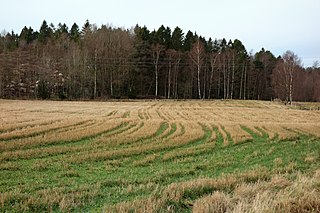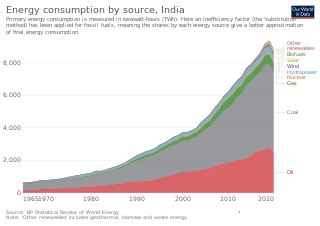
Smog, or smoke fog, is a type of intense air pollution. The word "smog" was coined in the early 20th century, and is a portmanteau of the words smoke and fog to refer to smoky fog due to its opacity, and odor. The word was then intended to refer to what was sometimes known as pea soup fog, a familiar and serious problem in London from the 19th century to the mid-20th century, where it was commonly known as a London particular or London fog. This kind of visible air pollution is composed of nitrogen oxides, sulfur oxide, ozone, smoke and other particulates. Man-made smog is derived from coal combustion emissions, vehicular emissions, industrial emissions, forest and agricultural fires and photochemical reactions of these emissions.

Solid fuel refers to various forms of solid material that can be burnt to release energy, providing heat and light through the process of combustion. Solid fuels can be contrasted with liquid fuels and gaseous fuels. Common examples of solid fuels include wood, charcoal, peat, coal, hexamine fuel tablets, dry dung, wood pellets, corn, wheat, rice, rye, and other grains. Solid fuels are extensively used in rocketry as solid propellants. Solid fuels have been used throughout human history to create fire and solid fuel is still in widespread use throughout the world in the present day.

Wood fuel is a fuel such as firewood, charcoal, chips, sheets, pellets, and sawdust. The particular form used depends upon factors such as source, quantity, quality and application. In many areas, wood is the most easily available form of fuel, requiring no tools in the case of picking up dead wood, or few tools, although as in any industry, specialized tools, such as skidders and hydraulic wood splitters, have been developed to mechanize production. Sawmill waste and construction industry by-products also include various forms of lumber tailings.

Crop residues are waste materials generated by agriculture. The two types are:

Coal pollution mitigation, sometimes labeled as clean coal, is a series of systems and technologies that seek to mitigate health and environmental impact of burning coal for energy. Burning coal releases harmful substances, including mercury, lead, sulfur dioxide (SO2), nitrogen oxides (NOx), and carbon dioxide (CO2), contributing to air pollution, acid rain, and greenhouse gas emissions. Methods include flue-gas desulfurization, selective catalytic reduction, electrostatic precipitators, and fly ash reduction focusing on reducing the emissions of these harmful substances. These measures aim to reduce coal's impact on human health and the environment.

Biomass, in the context of energy production, is matter from recently living organisms which is used for bioenergy production. Examples include wood, wood residues, energy crops, agricultural residues including straw, and organic waste from industry and households. Wood and wood residues is the largest biomass energy source today. Wood can be used as a fuel directly or processed into pellet fuel or other forms of fuels. Other plants can also be used as fuel, for instance maize, switchgrass, miscanthus and bamboo. The main waste feedstocks are wood waste, agricultural waste, municipal solid waste, and manufacturing waste. Upgrading raw biomass to higher grade fuels can be achieved by different methods, broadly classified as thermal, chemical, or biochemical.

Air pollution is the contamination of air due to the presence of substances called pollutants in the atmosphere that are harmful to the health of humans and other living beings, or cause damage to the climate or to materials. It is also the contamination of the indoor or outdoor environment either by chemical, physical, or biological agents that alters the natural features of the atmosphere. There are many different types of air pollutants, such as gases, particulates, and biological molecules. Air pollution can cause diseases, allergies, and even death to humans; it can also cause harm to other living organisms such as animals and crops, and may damage the natural environment or built environment. Air pollution can be caused by both human activities and natural phenomena.

Since 2013, total primary energy consumption in India has been the third highest in the world after China and United States. India is the second-top coal consumer in the year 2017 after China. India ranks third in oil consumption with 22.1 crore tons in 2017 after United States and China. India is net energy importer to meet nearly 47% of its total primary energy in 2019.

There are multiple environmental issues in India. Air pollution, water pollution, garbage, domestically prohibited goods and pollution of the natural environment are all challenges for India. Nature is also causing some drastic effects on India. The situation was worse between 1947 through 1995. According to data collected and environmental assessments studied by World Bank experts, between 1995 through 2010, India has made some of the fastest progress in addressing its environmental issues and improving its environmental quality in the world. However, pollution still remains a major challenge and opportunity for the country.

Slash-and-char is an alternative to slash-and-burn that has a lesser effect on the environment. It is the practice of charring the biomass resulting from the slashing, instead of burning it. Due to incomplete combustion (pyrolysis) the resulting residue matter charcoal can be utilized as biochar to improve the soil fertility.
Agricultural waste are plant residues from agriculture. These waste streams originate from arable land and horticulture. Agricultural waste are all parts of crops that are not used for human or animal food. Crop residues consist mainly of stems, branchs, and leaves. It is estimated that, on average, 80% of the plant of such crops consists of agricultural waste.

Pollution in California relates to the degree of pollution in the air, water, and land of the U.S. state of California. Pollution is defined as the addition of any substance or any form of energy to the environment at a faster rate than it can be dispersed, diluted, decomposed, recycled, or stored in some harmless form. The combination of three main factors is the cause of notable unhealthy levels of air pollution in California: the activities of over 39 million people, a mountainous terrain that traps pollution, and a warm climate that helps form ozone and other pollutants. Eight of the ten cities in the US with the highest year-round concentration of particulate matter between 2013 and 2015 were in California, and seven out of the ten cities in the US with the worst ozone pollution were also in California. Studies show that pollutants prevalent in California are linked to several health issues, including asthma, lung cancer, birth complications, and premature death. In 2016, Bakersfield, California recorded the highest level of airborne pollutants of any city in the United States.
Environmental problems in Delhi, India, are a threat to the well-being of the city's and area's inhabitants as well as the flora and fauna. Delhi, the ninth-most populated metropolis in the world (second largest if the entire NCR includes especially Faridabad and Gurugram– Haryana, is one of the most heavily polluted cities in India, having for instance one of the country's highest volumes of particulate matter pollution. The air quality index of Delhi is generally Good, Satisfactory and Moderate levels between March and September, and then it drastically deteriorates to Poor, Severe, or Hazardous levels in five months between October and February, due to various factors including stubble burning, burning of effigies during Vijayadashami, bursting of firecrackers burning during Diwali and cold weather. In May 2014 the World Health Organization announced New Delhi as the most polluted city in the world.

Air pollution in India is a serious environmental issue. Of the 30 most polluted cities in the world, 21 were in India in 2019. As per a study based on 2016 data, at least 140 million people in India breathe air that is 10 times or more over the WHO safe limit and 13 of the world's 20 cities with the highest annual levels of air pollution are in India. 51% of the pollution is caused by industrial pollution, 27% by vehicles, 17% by crop burning and 5% by other sources. Air pollution contributes to the premature deaths of 2 million Indians every year. Emissions come from vehicles and industry, whereas in rural areas, much of the pollution stems from biomass burning for cooking and keeping warm. In autumn and spring months, large scale crop residue burning in agriculture fields – a cheaper alternative to mechanical tilling – is a major source of smoke, smog and particulate pollution. India has a low per capita emissions of greenhouse gases but the country as a whole is the third largest greenhouse gas producer after China and the United States. A 2013 study on non-smokers has found that Indians have 30% weaker lung function than Europeans.

The air quality in Delhi, the capital territory of India, according to a WHO survey of 1,650 world cities, and a survey of 7,000 world cities by the US-based Health Effects Institute in August 2022, is the worst of any major city in the world. It also affects the districts around Delhi. Air pollution in India is estimated to kill about 2 million people every year; it is the fifth largest killer in India. India has the world's highest death rate from chronic respiratory diseases and asthma, according to the WHO. In Delhi, poor quality air irreversibly damages the lungs of 2.2 million or 50 percent of all children.

A Happy Seeder is a no-till planter, towed behind a tractor, that sows (plants) seeds in rows directly without any prior seedbed preparation. It is operated with the PTO of the tractor and is connected to it with three-point linkage. It consists of a straw managing chopper and a zero till drill that makes it possible to sow new crop in the residue of the previous crop. Flail type straight blades are mounted on the straw management rotor that chops the stubbles that comes in contact with the sowing tine. It deposits the residue of the previous crop over the sown field as mulch. Mainly, it is used to sow wheat after the paddy harvest in North India.

Vidyut Mohan is an Indian social entrepreneur. He is the co-founder of Takachar, a company that recycles agricultural waste into marketable carbon products, offering an alternative to the heavily polluting practice of burning agricultural byproducts.

A firecracker is a small explosive device primarily designed to produce a large amount of noise, especially in the form of a loud bang, usually for celebration or entertainment. They have fuses, and are wrapped in a heavy paper casing to contain the explosive compound. Firecrackers, along with fireworks, originated in China. They are easily available in India and are used to mark a celebratory event. Anyone 18 and over can buy them without a license if allowed by the local laws.
A super seeder is a no-till planter, towed behind a tractor, that sows (plants) especially wheat seeds in rows directly without any prior seedbed preparation. It is operated with the PTO of the tractor and is connected to it with three-point linkage. The Super Seeder is an advanced agricultural machine than Happy seeder, engineered to revolutionize traditional farming methods. It offers an efficient, time-saving solution, allowing farmers to sow wheat seeds directly after rice harvest without the need for prior stubble burning, thereby contributing significantly to environmental preservation. It is mostly used to sow wheat seeds after the paddy harvest in North Indian states.

















